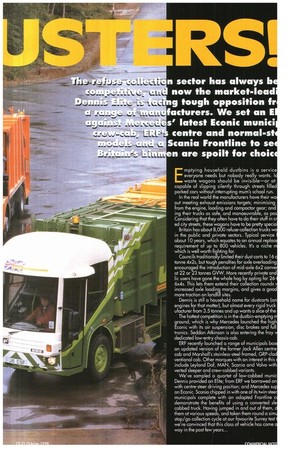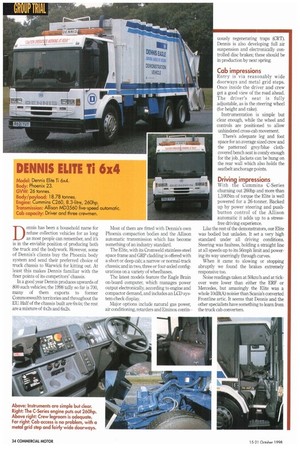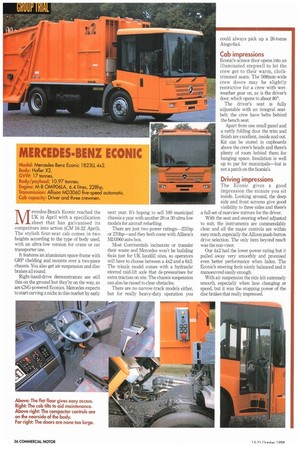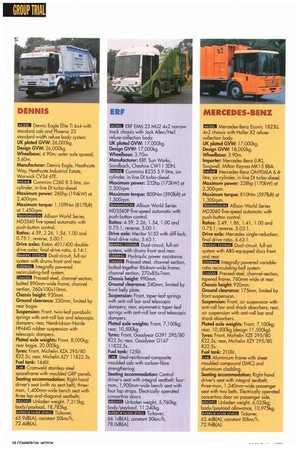n sector has always b now the market-lead g tough
Page 35

Page 36

Page 37

Page 38

Page 39

Page 40

Page 41

If you've noticed an error in this article please click here to report it so we can fix it.
opposition fr facturers. We set an E s' latest Econic munici centre and normal-st Scania Frontline to se n are spoilt for choic
Emptying household dustbins is a service everyone needs but nobody really wants. I waste wagons should be invisible—or at capable of slipping silently through streets filled parked cars without interrupting mum's school run. In the real world the manufacturers have their wo out meeting exhaust emissions targets; minimising From the engine, loading and compactor gear; and ing their trucks as safe, and manoeuvrable, as pos Considering that they often have to do their stuff in c ed city streets, these wagons have to be pretty specia Britain has about 8,000 refuse-collection trucks w in the public and private sectors. Typical service about 10 years, which equates to an annual replac requirement of up to 800 vehicles. It's a niche which is well worth fighting for. Councils traditionaHy limited their dustcarts to 16 tonne 4x2s, but tough penalties for axle overloading encouraged the introduction of mid-axle 6x2 conve at 22 or 23 tonnes GVW. More recently private and lic users have gone the whole hog by opting for 266xLts. This lets them extend their collection rounds increased axle loading margins, and gives a good more traction on landfill sites. Dennis is still a household name For dustcarts (an engines for that matter), but almost every rigid truck ufacturer from 3.5 tonnes and up wants a slice of the The hottest competition is in the dustbin-emptying ground, which is why Mercedes launched the high Econic with its air suspension, disc brakes and full tronics. Seddon Atkinson is also entering the fray dedicated low-entry chassis-cab. ERF recently launched a range of municipals bas an updated version of the former Jack Allen centre cab and Marshall's stainless-steel-framed, GRP-cla ventional cab. Other marques with an interest in this include Leyland Daf, MAN, Scania and Volvo with verted sleeper and crew-cabbed variants. We've sampled a quartet of low-cabbed munic Dennis provided an Elite; from ERF we borrowed an with centre-steer driving position; and Mercedes su an Econic. Scania chipped in with one of its twin-stee municipals complete with an adapted Frontline c demonstrate the benefits of using a converted sle cabbed truck. Having iumped in and out of them, them at various speeds, and token them round a sim stop/go collection cycle at our favourite Surrey test we're convinced that this class of vehicle has come way in the past few years... Dennis has been a household name for refuse collection vehicles for as long as most people can remember, and its is in the enviable position of producing both the truck and the bodywork. However, some of Dennis's clients buy the Phoenix body system and send their preferred choice of truck chassis to Warwick for kitting out. At least this makes Dennis familiar with the finer points of its competitors' chassis.
In a good year Dennis produces upwards of 800 such vehicles; the 1998 tally so far is 700, many of them exports to former Commonwealth territories and throughout the EU. Half of the chassis built are 6x4s; the rest are a mixture of 4x2s and 6x2.s. lost of them are fitted with Dennis's own Phoenix compaction bodies and the Allison automatic transmission which has become something of an industry standard.
The Elite, with its Cromweld stainless-steel space frame and GRP cladding is offered with a short or deep cab; a narrow or normal-track chassis; and in two, three or four-axled configurations on a variety of wheelbases.
The latest models feature the Eagle Brain on-board computer, which manages power output electronically, according to engine and compactor demand, and includes an LCD system-check display.
Major options include natural gas power, air conditioning, retarders and Eminox contin
uously regenerating traps (CRT). Dennis is also developing full air suspension and electronically controlled disc brakes; these should be in production by next spring.
Cab impressions
Entry is via reasonably wide doorways and metal grid steps. Once inside the driver and crew get a good view of the road ahead. The driver's seat is fully adjustable, as is the steering wheel (for height and rake).
Instrumentation is simple but clear enough, while the wheel and controls are positioned to allow unhindered cross-cab movement.
There's adequate leg and foot space for an average sized crew and the patterned grey/blue clothcovered bench seat is comfy enough for the job. Jackets can be hung on the rear wall which also holds the seatbelt anchorage points.
Driving impressions
With the Cummins C-Series churning out 260hp and more than 1,100Nm of torque the Elite is well powered for a 26-tonner. Backed up by power steering and pushbutton control of the Allison automatic it adds up to a stressfree driving experience.
Like the rest of the demonstrators, our Elite was bodied but unladen. It set a very high standard under all driving conditions. Steering was faultess, holding a straight line at all speeds up to its 56mph limit and powering its way unerringly through curves.
When it came to slowing or stopping abruptly we found the brakes extremely responsive too.
Noise readings taken at 501an/h and at tickover were lower than either the ERF or Mercedes, but amazingly the Elite was a whole 10dB(A) noisier than Scania's converted Frontline artic. It seems that Dennis and the other specialists have something to learn from the truck cab converters.
ERF has sold municipals with adapted sleeper cabs for some years now—it recently sold five EC 6x2s with crew-cab conversions to the London Borough of Croydon.
Having moved into the dedicated municipal arena with its own EM version of the Jack Allen centre-steer cab and the more traditional Marshall-built EC cab, ERF can now claim to offer the widest range of refuse collectors in the business.
Both of its municipals are innovative in their own right. The EC's forward tapering cab has an unusual driving position with the crew seated up behind the driver's shoulders in the cockloft; the flat-fronted Cromweldframed Marshall features a distinctive deep coach-derived windscreen and back-of-cab hydraulics and engine cooling pack.
Each of these models is available as a 4x2, a 6x2 with mid-lift axle, or a 6x4 with a choice of short or full crew-cab. The EM, unlike the Marshall, can be supplied with a narrow track. Operators can also specify 8x4s for heavy duty or front end loader work.
Our demonstrator was a narrow track model which offered plenty of room for a driver and crewmen.
Cab impressions
ERF's range is unique among modern refuse collection trucks, and its design makes a great deal of sense. The front tapers inwards and the doorways are quite wide, which enhances driver and crew safety.
This is a genuine one-step-entry cab which gives super access on both sides for driver and crew. Full-height scissor doors have controls inside and out, and there are three steps up to the crew seats which are comfortable, despite being covered in washable heavy-duty vinyl.
The flooring and steps are all made of moulded GRP with a rough surface that looks like the aftermath of an explosion in an undersea! factory. The steps slope slightly for hosing out and have a gritty feel which is fine in dry weather, but when wet they do feel slippery.
The cab was designed to give the seated crew good views all round, and it shows. Stowage is restricted to a shallow cupboard behind the two inner seats.These are a bit short on knee room, but the outer seats have plenty, which is likely to cause some bickering among the crews. For travelling safety there's a long rail with drop-down bars, lap straps for the crew and an integral belt in the driver's seat.
Driving impressions
Our ERF EM6 demonstrator with its 232hp Cummins B-Series and Allison auto box was certainly an interesting vehicle to drive. The steering and controls are conventional but the centre seat takes a little getting used to. For a start you have to look in each mirror regularly and position yourself between the white lines. The wide-set mirrors give superb rearward vision but they stick out a long way which might cause problems where access is restricted.
Above each doorway are ledges that stop rain falling on the steps and also carry kerb mirrors.
The EM6 isn't short on power and it manoeuvres easily through tight spots at low speeds but at speeds above 30mph the rear end does tend to wag and it becomes a little unsteady on the curves. According to ERF our demonstrator's steering geometry was a little out of kilter but has since been re-aligned.
There's no shortage of stopping power, although the pedal needed a hard shove to get the best result Noise levels are high, possibly due to the folding door arrangement, and you can't reach the sun visors without standing up. One welcome feature is that the cab places the driver eye-to-eye with pedestrians, so while they express their road rage you can retort with wheelie-bin rage, with interest.
The EM6 is certainly an interesting concept and, apart from a few quirks, one with great potential.
Mercedes-Benz's Econic reached the UK in April with a specification sheet that has galvanised its competitors into action (CM 16-22 April). The stylish four-seat cab comes in two heights according to the type of body used, with an ultra-low version for crane or car transporter use.
It features an aluminium space-frame with GRP cladding and mounts over a two-piece chassis. You also get air suspension and disc brakes all round_ Right-hand-drive demonstrators are still thin on the ground but they're on the way, as are CNO-powered Econics. Mercedes expects to start carving a niche in this market by early next year. It's hoping to sell 100 municipal chassis a year with another 20 or 30 ultra-low models for aircraft refuelling.
There are just two power ratings-231hp or 270hp—and they both come with Allison's MD3060 auto box.
Most Continentals incinerate or transfer their waste and Mercedes won't be building 6x4s just for UK landfill sites, so operators will have to choose between a 4x2 and a 6x2. The triaxle model comes with a hydraulic steered mid-lift axle that de-pressurises for extra traction on site. The chassis suspension can also be raised to clear obstacles.
There are no narrow-track models either, but for really heavy-duty operation you could always pick up a 26-tonne Atego 6x4.
Cab impressions
Econic's scissor door opens into an illuminated stepwell to let the crew get to their warm, clothtrimmed seats. The 508mm-wide crew doors may be slightly restrictive for a crew with wetweather gear on, as is the driver's door, which opens to about 800.
The driver's seat is fully adjustable with an integral seatbelt; the crew have belts behind the bench seat.
Apart from one small panel and a rattly folding door the trim and finish are excellent, inside and out. Kit can be stored in cupboards above the crew's heads and there's plenty of room behind them for hanging space. Insulation is well up to par for municipals—but is not a patch on the Scania's.
Driving impressions
The Econic gives a good impression the minute you sit inside. Looking around, the deep side and front screens give good visibility to three sides and there's a full set of rearview mirrors for the driver.
With the seat and steering wheel adjusted to suit, the instruments are commendably clear and all the major controls are within easy reach, especially the Allison push-button drive selection. The only item beyond reach was the sun-visor.
Our 4x2 had the lower power rating but it pulled away very smoothly and promised even better performance when laden. The Econic's steering feels nicely balanced and it manoeuvred easily enough.
With air suspension the ride felt extremely smooth, especially when lane changing at speed, but it was the stopping power of the disc brakes that really impressed.
Scania's only specialist representative in the municipal market is the Frontline-cabbed chassis which is available as a 4x2, a 6x214 and an 8x4. The 4x2 isn't the lightest vehicle in its class, which is why Scania advises buyers to take it with a Granning axle conversion for the extra payload.
Last year Scania sold more than 100 3-Series Frontliners, 90 of which were 6x4s with heavy-duty Allison HD4560 gearboxes. Most of these were earmarked for use on road and landfill work—the rest were 6x2s for use at transfer stations.
Sales are holding steady following the recent arrival of the 4-Series muni'—more than 70 examples have been sold this year to private and local authority fleets, so the company is on course to match last year's total. Frontline municipals are offered with day or crew-cabs; Scania has enough confidence in its three-axled versions to build them for stock.
For our appraisal it provided a 260hp twinsteer model with a Faun Rotopress body.
Cab impressions
Scania's big Frontline cab is a factory conversion with extra floor plates over the original bunk area, a heavy-duty shelf over the screen and a sturdy bench seat.
The cab is also mounted slightly ahead of its normal truck position. This allows wider steps to be used, which is good news for the driver. Inside there's the usual range of Scania driver comforts including a well sprung, fully adjustable seat and adjustable steering wheel, with a cockpit-like driving compartment and high driving position.
There's no slipping across the seat, however: if the driver needs to help with the bins he has to climb out the way he climbed in. On busy street collections the crew will need the legs of mountain goats because it's a fair old climb up the four steps and into the furthest seat.
Both outer seats offer plenty of legroom but the inner seats forfeit theirs to avoid interfering with the driver. There are no seatbelts for the crew but Scania does include well placed safety railings, plenty of stowage space and coat hooks. There's also a roof vent and a shallow window in the header panel, but while the driver has excellent views all round the same can't be said for the crew. With all the windows closed it could get a little claustrophobic.
Driving impressions
When parked up it might look like a large, lumbering beast but out on the road the twin-steer Scania is transformed. It pulls strongly through the automatic gears and handles superbly.
Despite its high stance the Scania can be driven confidently along twisting roads without any adverse effect the steering is nice and responsive. It's also nicely balanced, especially when its comes to manoeuvring back and forth in tight confines, which is just the job for working on city streets.
We were pleasantly surprised by its ultralow noise levels which were around 10dB(A) below the rest of the group, both at speed and when ticking over at the kerbside.
DENNIS ELITE Ti 6x4
Model: Dennis Elite Ti &A.
Body: Phoenix 23, GVVV: 26 tonnes.
Body/payload: 18.78 tonnes. Engine: Cummins C260, 8.3-litre, 260hp. Transmission: Allison MD3560 five-speed automatic.
Cab capacity: Driver and three crewmen.
ERF EM6.23 MU2
Model: ERF EM6.23 MU2 (2.2m track) 4x2.
Body: Jack Allen.
GVW: 17 tonnes.
Body/payload: 11.24 tonnes. Engine: Cummins B235, 5.9 litres, 232hp. Transmission: Allison MD3560 five-speed automatic. Cab capacity: Driver and four crewmen.
MERCEDES-BENZ ECONIC
Model; Mercedes-Benz Econic 1 823LL 4x2.
Body: Haller X2.
GVW: 17 tonnes.
Body/payload: 10.97 tonnes.
Engine: M-B 0M906LA, 6.4 litres, 228hp. Transmission: Allison MD3060 five-speed automati Cab capacity: Driver and three crewmen.
SCANIA P94DB
Model: Scania P94DB Frontline 6x2.
Body: Faun Rotopress 2000.
GVW: 25.5 tonnes.
Body/payload: 17.56 tonnes. Engine: Scania DSC9-12, 9.0 litres, 256hp. Transmission: Allison MD3066P six-speed automatic.
Cab capacity: Driver and four crewmen.
DENNIS
I= Dennis Eagle Elite Ti 6x4 with standard cab and Phoenix 23 standard-width refuse body system. UK plated GVW: 26,000kg.
Design GVW: 26,000kg.
Wheelbase: 4.90m; outer axle spread, 5.60m.
Manufacturer: Dennis Eagle, Heathcote Way, Heathcote Industrial Estate, Warwick CV34 61E.
EMMA Cummins C260 8.3-litre, sixcylinder, in-line DI turbo-diesel. Maximum power: 260hp (194kW) at 2,40Orpm.
Maximum torque: 1,109Nm (81711A) at 1,45Orpm.
=MEI Allison World Series MD3560 five-speed automatic with push-button control.
Ratios: 4.59, 2.26, 1.54, 1.00 and 0.75:1; reverse, 5.00:1.
Drive axles: Eaton 401/400 doubledrive axles; final-drive ratio, 6.14:1. MIENU1I11 Dual-circuit, full-air system with drums front and rear. =MI Integrally powered recirculating-ball system.
IMO Pressed-steel, channel-section, bolted 890mm-wide frame; channel section, 260x100x10mm.
Chassis height: 930mm.
Ground clearance: 230mm, limited by rear bogie.
Suspension: Front, twin-leaf parabolic springs with anti-roll bar and telescopic dampers; rear, Hendrickson-Norde HN440 rubber suspension with telescopic dampers.
Plated axle weights: Front, 8,000kg; rear bogie, 20,000kg.
Tyres: Front, Michelin XZA 295/80 R22.5s; rear, Michelin XZY 11 R22.5s. Fuel tank: 164Iit.
IELEI Cromweld stainless-steel spaceframe with moulded GRP panels. Seating accommodation: Right-hand driver's seat (with no seat belt); threeman, 1,400mm-wide bench seat with three lap-and-diagonal seatbelts. =3 Unladen weight, 7,215kg; body/payload, 18,785kg.
INTERIOR NOISE LEVELS:
Tickover, 65.9dB(A); constant 50km/h, 72.4cIB(A).
ERF
122:21111 ERF EM6.23 MU2 4x2 narrowtrack chassis with Jack Allen/Heil refuse-collection body.
UK plated GVW: 17,000kg.
Design GVW: 17,000kg.
Wheelbase: 3.70m.
Manufacturer: ERF, Sun Works, Sandbach, Cheshire CW11 3DN. IME1 Cummins B235 5.9-litre, sixcylinder, in-line DI turbo-diesel. Maximum power: 232hp (173kW) at 2,50Orpm.
Maximum torque: 800Nm (590Ibft) at 1,50Orpm.
01=11 Allison World Series MD3560P five-speed automatic with push-button control.
Ratios: 4.59, 2.26, 1.54, 1.00 and 0.75:1; reverse, 5.00:1.
Drive axle: Mentor 5153 with diff-lock; final drive ratio, 5.63:1. 0-1=1201/233 Dual-circuit, full-air system, with drums front and rear. EM031 Hydraulic power assistance. MIMI Pressed-steel, channel-section, bolted-together 864mm-wide frame; channel section, 270x85x7mm. Chassis height: 990mm.
Ground clearance: 240mm, limited by front belly plate.
Suspension: Front, taper-leaf springs with anti-roll bar and telescopic dampers; rear, asymmetric taper-leaf springs with anti-roll bar and telescopic dampers.
Plated axle weights: Front, 7,100kg; rear, 10,500kg.
Tyres: Front, Goodyear G391 295/80 R22.5s; rear, Goodyear G167 11R22.5s.
Fuel tank: 125Iit.
Steel-reinforced-composite moulded cab with carbon-fibre strengthening.
Seating accommodation: Central driver's seat with integral seatbelt; fourman, 1,900mm-wide bench seat with four lap straps. Electrically operated concertina doors.
=fa Unladen weight, 5,760kg; body/payload, 11 ,240k9.
INTERIOR NOISE LEVELS: Tickover, 66.1dB(A); constant 50km/h, 78.0dB(A).
MERCEDES-BENZ
EMI Mercedes-Benz Econic 1823LL 4x2 chassis with Haller X2 refusecollection body.
UK plated GVW : 17,000kg.
Design GVW: 18,000kg.
Wheelbase: 3.90m.
Importer: Mercedes-Benz (UK), Tongwell, Milton Keynes MK15 8BA. MEM Mercedes-Benz 0M9061A 6.4litre, six-cylinder, in-line DI turbo-diesel. Maximum power: 228hp (170kW) at 2,30Orpm.
Maximum torque: 810Nm (597Ibft) at 1,30Orpm.
=MEM Allison World Series MD3060 five-speed automatic with push-button control. Ratios: 3.49, 1.86, 1.41, 100 and 0.75:1; reverse, 5.03:1.
Drive axle: Mercedes single-reduction; Final drive ratio, 6.63:1.
Dual-circuit, full-air system with ABS-equipped discs front and rear.
IMIMMI Integrally powered variableratio recirculating-ball system.
=DM Pressed-steel, channel-section, tapered frame, 760mm wide at rear. Chassis height: 920mm.
Ground clearance: 175mm, limited by front suspension.
Suspension: Front, air suspension with anti-roll bar and shock absorbers; rear, air suspension with anti-roll bar and shock absorbers.
Plated axle weights: Front, 7,100kg; rear, 10,500kg (design 11,500kg). Tyres: Front, Michelin XZE 295/80 R22.5s; rear, Michelin XZY 295/80 R22.5s.
Fuel tank: 21 Olit.
LEI Aluminium frame with sheet moulded compound (WC) and aluminium cladding.
Seating accommodation: Right-hand driver's seat with integral seatbelt; three-man, 1,340mm-wide passenger seat with two belts. Electrically operated concertina door on passenger side. =MI Unladen weight, 6,025kg; body/payload allowance, 10,975kg. Tickover, 62.4d8(A); constant 50km/h, 72.9dB(A),
BRAKING SYSTEMS: INTERIOR NOISE LEVELS:
SCANIA
P94DB6x2/4 NA220 6x2 twin-steer chassis with Frontline crewcab and Faun Rotopress 2000 refusecollection body.
UK plated GVVV: 25,500kg.
Design GVW: 25,500k9.
Wheelbase: 4.94m; outer axle spread, 5.50m.
Importer: Scania (Great Britain), Tongwell, Milton Keynes MK15 8HB. MEM Scania DSC9-12 "260" 9.0litre, six-cylinder, in-line DI turbo-diesel. Maximum power: 256hp (191 kw) at 2,00Orpm.
Maximum torque: 1,180Nm (870Ibft) at 1,35Orpm.
82=1E211 Allison World Series MD3066P six-speed automatic with push-button control (bodged Scania GA751), Drive axle: Scania ADA1300; finaldrive ratio, 5.5 7: 1 .
BRAKING SYSTEMS:
Dual-circuit, full-air system with ABS-equipped drums front and rear.
1261=1 Integral hydraulic powerassisted system.
MIMI Pressed-steel, channel-section, riveted, 770mm-wide frame.
Chassis height: 1,030mm.
Ground clearance: 265mm, limited by rear air bags.
Suspension: Front, semi-elliptic leaf springs with anti-roll bar and telescopic shock absorbers; rear, quarter-elliptic springs with air bellows (and pneumatic mid-axle hoist) with telescopic shock absorbers, Plated axle weights: Front, 7,500kg; rear bogie, 20,500kg.
Tyres: Front and mid (steer) axles, Goodyear G391 315/80 R22,5s; rear, Goodyear G267 315/80 R22.5s. Fuel tank: 3001it.
Frontline, galvanised steel. Seating accommodation: Right-hand driver's seat with integral seatbelt; fourman, 2,020mm-wide bench seat with no seat belts.
=II Unladen weight, 7,940kg; body/payload, 17,56063.
CAB: INTERIOR NOISE LEVELS:
Tickover, 55.5dB(A); constant 50km/h, 63.4dB(A).




















































































































